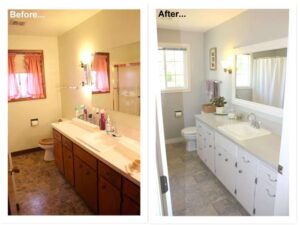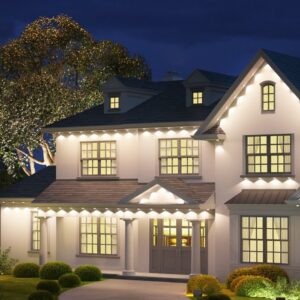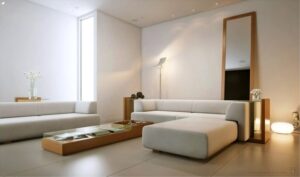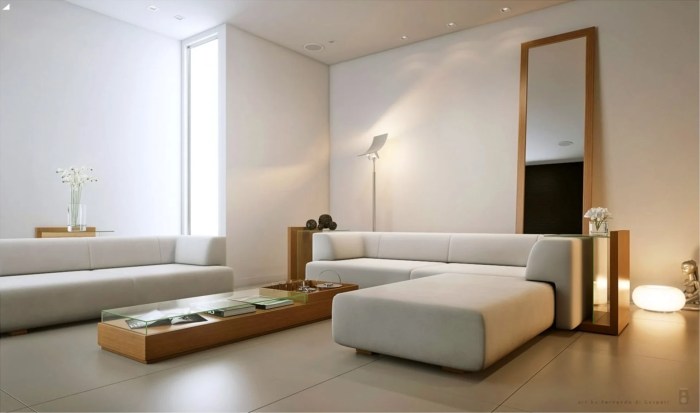
Minimalist interior decor stands at the intersection of form and function, celebrating simplicity while delivering sophisticated style. By stripping away the excess, minimalist design allows each element to shine, creating spaces that are not only visually appealing but also promote a sense of serenity and order.
This design philosophy focuses on essentiality, favoring clean lines and muted color palettes. Popular choices often include whites, blacks, and earthy tones, delivering a peaceful backdrop that can enhance the functionality of any room. Whether you’re looking to enhance your home’s aesthetic or improve its value in the real estate market, understanding the principles of minimalism is essential.
Minimalist Interior Design Principles

Minimalist interior design is all about creating spaces that emphasize simplicity, functionality, and a connection to the surrounding environment. This design philosophy aims to eliminate clutter and distractions, allowing individuals to appreciate the beauty of essential elements. By focusing on a few key principles, minimalist design not only enhances the aesthetics of a space but also promotes a sense of calm and order.The core principles of minimalist interior design revolve around simplicity, functionality, and quality over quantity.
This approach encourages the use of space in a way that maximizes light and air while minimizing unnecessary ornamentation. By embracing this philosophy, homeowners can create serene environments that reflect their personal style without overwhelming the senses. Minimalism is not just about visual aesthetics; it also prioritizes functional living. Here are some essential aspects to consider:
Color Palettes in Minimalist Decor
In minimalist design, color palettes play a crucial role in achieving the desired atmosphere. The right colors can create a sense of harmony and balance, contributing to the overall simplicity of the space. Commonly used palettes often consist of neutral shades, which help to maintain a clean and uncluttered look. Below are some examples of color palettes that work well in minimalist interiors:
- Monochromatic: Utilizing varying shades of a single color, such as different tones of gray, fosters a cohesive look.
- Earth Tones: Colors inspired by nature—browns, greens, and soft whites—bring warmth and a grounding feel to minimalist spaces.
- Black and White: The classic combination offers a bold yet timeless aesthetic, creating striking contrasts that enhance the simplicity of design.
- Pastels: Soft pastels can add a touch of color without overwhelming the minimalistic approach, providing a gentle and calming environment.
Importance of Functionality in Minimalist Spaces
Functionality is a cornerstone of minimalist interior design. Each element within a space should serve a purpose, contributing to the overall usability and efficiency. This principle is particularly important in small spaces, where every square foot counts. By focusing on multifunctional furniture and smart storage solutions, homeowners can ensure their spaces are both aesthetically pleasing and practical. In a minimalist home, furniture choices often reflect this principle.
For instance, a coffee table with built-in storage can reduce clutter while maintaining a sleek profile. Similarly, modular furniture that adapts to various needs enhances the functionality of the space. Here are some key points highlighting the significance of functionality in minimalist design:
- Maximizes Space: Functional furniture optimizes space usage, making it easier to navigate and maintain order.
- Encourages Organization: Well-designed storage solutions promote organization, which is essential in minimalist design.
- Enhances Comfort: Functionality often leads to increased comfort, as spaces are tailored to the user’s needs.
- Supports Lifestyle: A functional approach allows individuals to create environments that reflect and support their daily activities.
Incorporating Minimalism in Real Estate
Minimalist decor has become increasingly popular in the real estate market, and its impact on property value is significant. By emphasizing simplicity, functionality, and clean lines, minimalist design not only appeals to a wide range of buyers but also creates a sense of spaciousness that enhances the overall aesthetic of a property. This approach can lead to higher selling prices and quicker sales, making it an effective strategy for homeowners and real estate agents alike.Staging a home with minimalist design requires careful planning and consideration.
The goal is to create an inviting atmosphere while showcasing the property’s best features. A well-executed minimalist design can help potential buyers envision themselves in the space, ultimately influencing their purchasing decision.
Enhancing Property Value with Minimalist Decor
The integration of minimalist decor into a home can significantly elevate its market value. By focusing on essential elements and eliminating excess, homeowners create a more attractive space that resonates with buyers. Key aspects include:
- Increased perceived value: Minimalist homes are often associated with higher quality and better maintenance, making them more desirable to buyers.
- Broader appeal: A clean, uncluttered environment allows potential buyers to imagine their own style within the space, increasing emotional attachment.
- Enhanced natural light: Minimalist design often incorporates large windows and open spaces that maximize natural light, contributing to a welcoming atmosphere.
- Low upkeep: Fewer decorative items mean less maintenance and cleaning, which is appealing to busy families and individuals.
Strategies for Staging a Home with Minimalist Design
Effective home staging plays a crucial role in attracting potential buyers. To create an appealing minimalist environment, consider the following strategies:
- Declutter: Remove unnecessary items to create a clean and spacious look. This allows buyers to focus on the home’s architecture and features.
- Neutral color palette: Utilize soft, neutral colors to create a calming atmosphere that appeals to a diverse range of tastes.
- Functional furniture: Choose furniture pieces that are not only aesthetically pleasing but also serve a purpose, avoiding overly ornate or bulky items.
- Highlight key features: Arrange furniture to draw attention to architectural elements, such as fireplaces or large windows, enhancing their visual impact.
Key Features that Attract Buyers to Minimalist Homes
Certain features within minimalist homes tend to resonate strongly with buyers. These elements enhance the overall appeal and desirability of the property:
- Open floor plans: Spacious layouts allow for flexibility in how spaces are used, promoting a sense of freedom and light.
- Natural materials: Incorporating wood, stone, and other organic materials can add warmth and character to a minimalist design.
- Smart storage solutions: Built-in shelving and concealed storage options help maintain an uncluttered environment, which is a hallmark of minimalist design.
- Energy efficiency: Homes that feature energy-efficient systems and appliances are increasingly appealing, aligning with the minimalist ethos of sustainability.
Minimalist Home Improvement and Gardening
Creating a minimalist home goes beyond the interiors; it extends into the garden and overall home improvement strategies. A minimalist approach emphasizes simplicity, functionality, and the reduction of clutter—principles that can transform both indoor and outdoor spaces into serene environments. This discussion will cover methods for establishing a minimalist garden, tips for selecting multifunctional furniture, and innovative storage solutions that align with minimalist principles.
Creating a Minimalist Garden
A minimalist garden serves as an extension of your indoor space, promoting tranquility and simplicity. To achieve this aesthetic, consider the following key elements:
- Plant Selection: Choose a limited variety of plants that complement your home’s color palette. Opt for native species or low-maintenance options that require less upkeep.
- Use of Hardscaping: Incorporate stones, gravel, or concrete pathways to define areas without overwhelming the senses. This not only adds structure but also reduces the need for extensive landscaping.
- Open Spaces: Maintain clear spaces devoid of excessive furniture or decorations. Let the garden breathe, allowing for easy movement and an inviting atmosphere.
- Vertical Gardens: Utilize vertical space by incorporating wall planters or trellises. This maximizes your garden area while keeping the ground clear and organized.
“A garden is a reflection of the inner self; simplicity can cultivate profound peace.”
Selecting Multifunctional Furniture
For a minimalist home, furniture should not only be aesthetically pleasing but also functional. Choosing multifunctional pieces can significantly enhance your living space without adding clutter. Consider these suggestions:
- Convertible Sofa Beds: Perfect for small spaces, these sofas can transform into beds for guests, thereby combining comfort and functionality.
- Storage Ottomans: These versatile pieces serve as seating, footrests, and hidden storage for blankets or books, helping to reduce visible clutter.
- Wall-Mounted Desks: Ideal for limited space, these desks can be folded away when not in use, keeping the area open and airy.
- Expandable Dining Tables: These tables can adjust in size based on your needs, making them suitable for both intimate dinners and larger gatherings.
Innovative Storage Solutions
Effective storage is essential in maintaining a minimalist home. Clever storage solutions can help ensure that every item has its place, promoting a clean and organized living environment. Key strategies include:
- Built-in Shelving: Custom built-in shelves can maximize vertical space and provide a sleek way to display books and decor without overcrowding surfaces.
- Under-Bed Storage: Utilize the space beneath your bed for boxes or drawers to store seasonal clothing or extra linens, keeping them out of sight but easily accessible.
- Multi-purpose Rooms: Designate certain areas for multiple functions, like a guest room that doubles as a home office, using furniture that can adapt to both needs.
- Clear Containers: Using transparent bins for storage allows you to quickly identify contents while keeping everything neat and organized.
“Less is more. The beauty of minimalism lies in its simplicity.”
Ultimate Conclusion
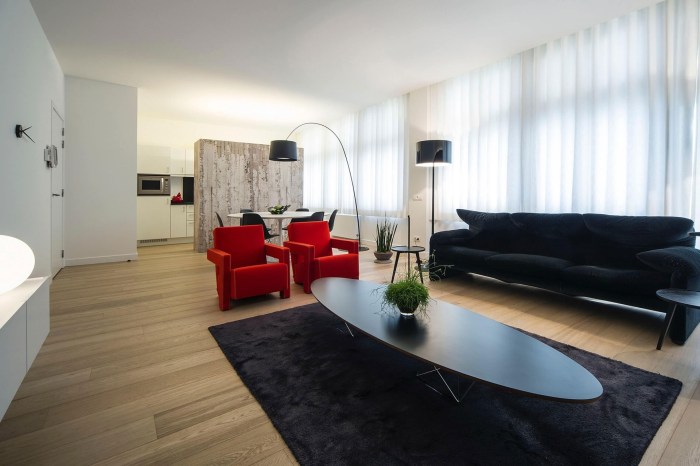
In summary, embracing minimalist interior decor can transform your living space into a haven of tranquility and elegance. By prioritizing functionality and thoughtful design, you not only create a beautiful environment but also a more organized and mindful lifestyle.
Detailed FAQs
What are the core principles of minimalist interior design?
The core principles include functionality, simplicity, and the use of a limited color palette.
How can I maintain a minimalist home?
Regularly declutter, choose multifunctional furniture, and limit decorative items to keep spaces open and airy.
What colors are best for minimalist decor?
Neutral colors like white, beige, gray, and soft earth tones are ideal for creating a calming minimalist atmosphere.
How does minimalist decor impact property value?
Minimalist decor can enhance property value by appealing to buyers looking for modern, clean, and organized spaces.
Can I incorporate plants into a minimalist design?
Absolutely! Select a few well-placed, simple plants that complement the overall aesthetic without overcrowding the space.
